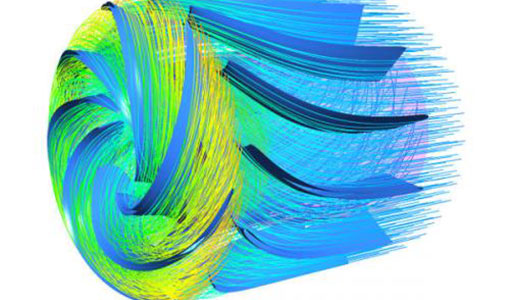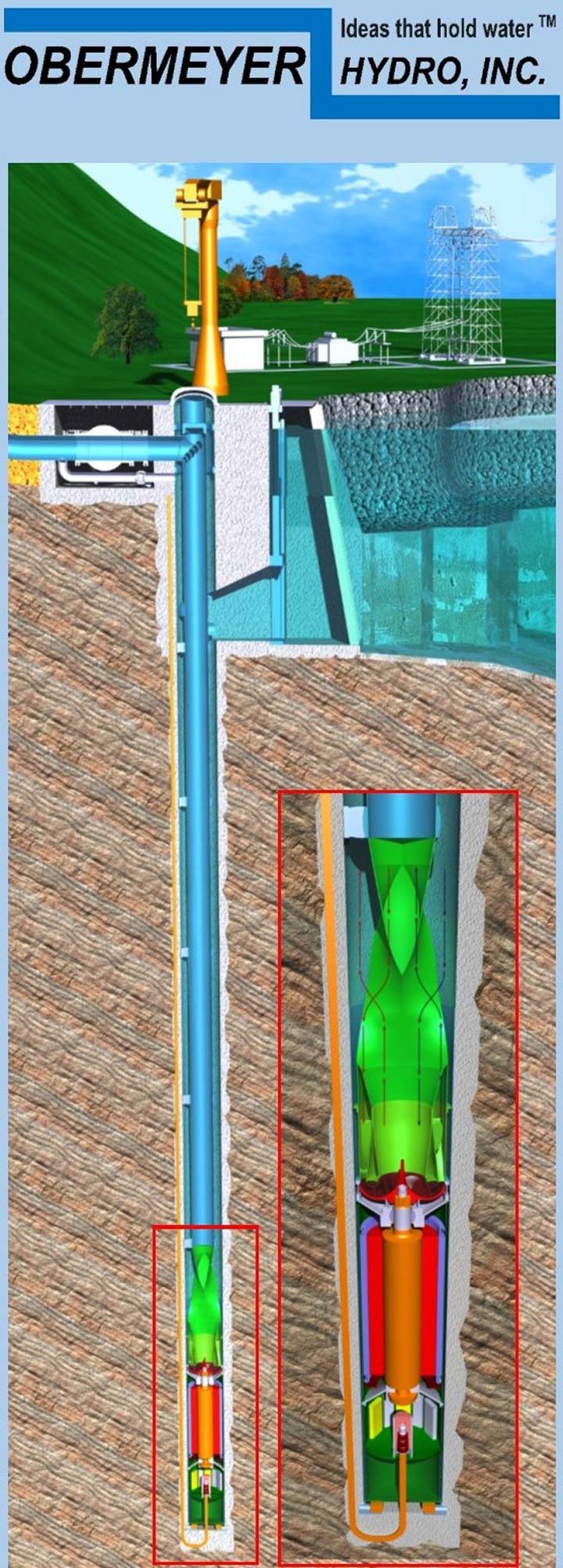Novel Design Configuration Increases Market Viability for Pumped-Storage Hydropower in the United States

Obermeyer's reversible pump turbine is enabling PSH projects to deploy with less substantial civil construction and equipment component costs. Illustration courtesy of Obermeyer Hydro, Inc.
Did you know that pumped-storage hydropower (PSH) provides 95% of all utility-scale energy storage in the United States? To further the development of this important technology, the National Renewable Energy Laboratory (NREL) is supporting Obermeyer Hydro, Inc., in their efforts to design a cost-effective, highly flexible PSH system that reduces project costs, shortens deployment timelines, and is optimized for U.S. energy storage requirements.
Obermeyer was awarded $1.18 million to develop an advanced closed-loop PSH configuration as part of the U.S. Department of Energy Water Power Technologies Office’s HydroNEXT initiative. The initiative focuses on lowering costs, improving performance, and promoting environmental stewardship in the context of closed-loop PSH systems.
NREL and Obermeyer, along with partners Microtunneling Inc. and Small Hydro Consulting, demonstrated the advantage of using a small modular system to help address some of the challenges conventional designs face in the hydropower industry.

As the amount of wind and solar on the grid increases, the demand for high-capacity, longer-duration storage is expected to grow, and NREL-led assessments are helping the hydropower industry explore these grid storage opportunities from both a techno-economic and an engineering perspective.
Key to this new design is that it does not require an underground powerhouse, which is one of the more costly, risky, and environmentally impactful aspects of PSH construction. NREL researchers worked with Auburn University to perform an economic analysis of this novel PSH design. The team’s research showed project cost reductions of 33%, including a 45% savings in construction-related costs, while simultaneously eliminating the geologic risk of underground powerhouse construction.
The team also verified the computational fluid dynamics analysis of the pump-turbine’s performance; the predicted round trip efficiency makes this technology highly competitive in the energy storage technology space.
“We’re investigating ways to best meet large-scale grid storage needs while also tackling problems facing today’s electric power sector,” said Greg Stark, a principal investigator at NREL. “Obermeyer’s adjustable-speed pumped-storage hydropower system shows several significant advantages—it is highly scalable, adaptable to a number site types, and the design addresses project cost, timeline, and risk concerns.”
Finding Common Ground
All reversible pump turbines have strict design-specific submergence requirements—they require installation at depths significantly below the tailwater surface elevation to prevent destructive cavitation. Installation of the submersible pump turbine in a vertical “well,” rather than a traditional underground powerhouse, not only reduces construction cost and project risk but also allows installation under geologic conditions not suitable for an underground powerhouse.
However, this created a related challenge. To substitute a simple “well” for an underground powerhouse, a more compact pump turbine was required. An innovative runner design, with a 180-degree meridional flow reversal, made the required compact form factor possible. “The entire project team expected an efficiency penalty due to this 180-degree flow reversal,” said Henry Obermeyer, Obermeyer Hydro, Inc.,’s president and chief engineer. “By comparison, the flow in a conventional Francis pump turbine runner is only diverted 90 degrees. This novel arrangement required a coaxial diffuser, which unexpectedly outperformed a traditional scroll case diffuser and yielded a net efficiency bonus rather than the anticipated efficiency penalty.”
This innovative pumped-storage approach makes the development of PSH projects in the 1- to 100-MW range much more attractive from both a site selection and a project economics perspective, opening up new opportunities for PSH.
“Only 3% of all dam infrastructure in the United States generates power,” said Katherine Obermeyer, strategic project manager of Obermeyer. “By tapping into nonpowered dams with our scalable and versatile solution, we can facilitate increasing amounts of renewable energy storage throughout the country.”
This pump-turbine design has the potential to be used in a wide range of closed-loop and open-loop pumped storage projects, using combinations of aboveground and underground reservoirs, seawater, and potable water storage. Non-storage applications include high-efficiency pumps for water supply and conveyance and premium-efficiency well pumps.
Learn more about NREL’s research in hydropower and PSH technologies.
Last Updated May 28, 2025
